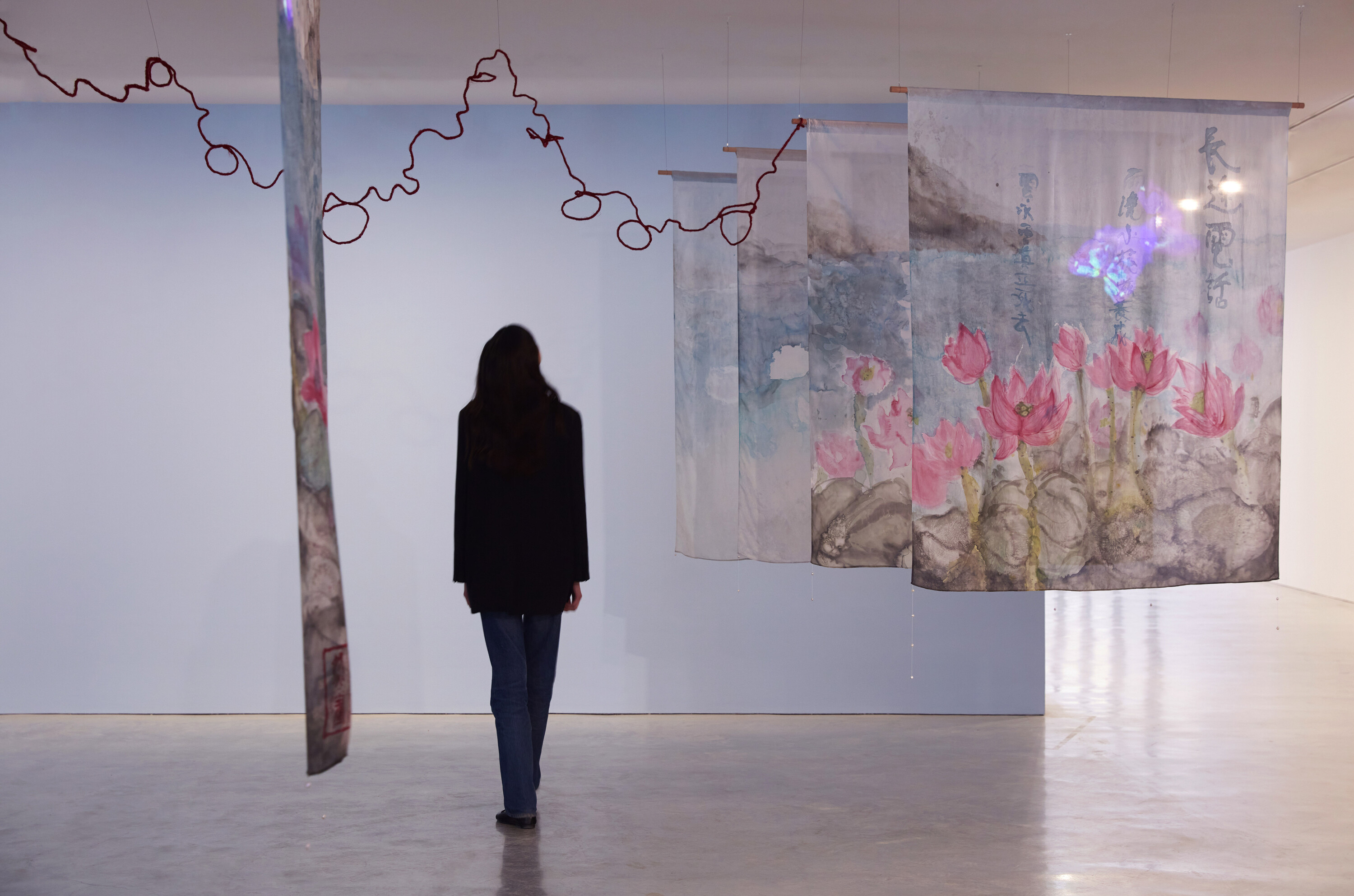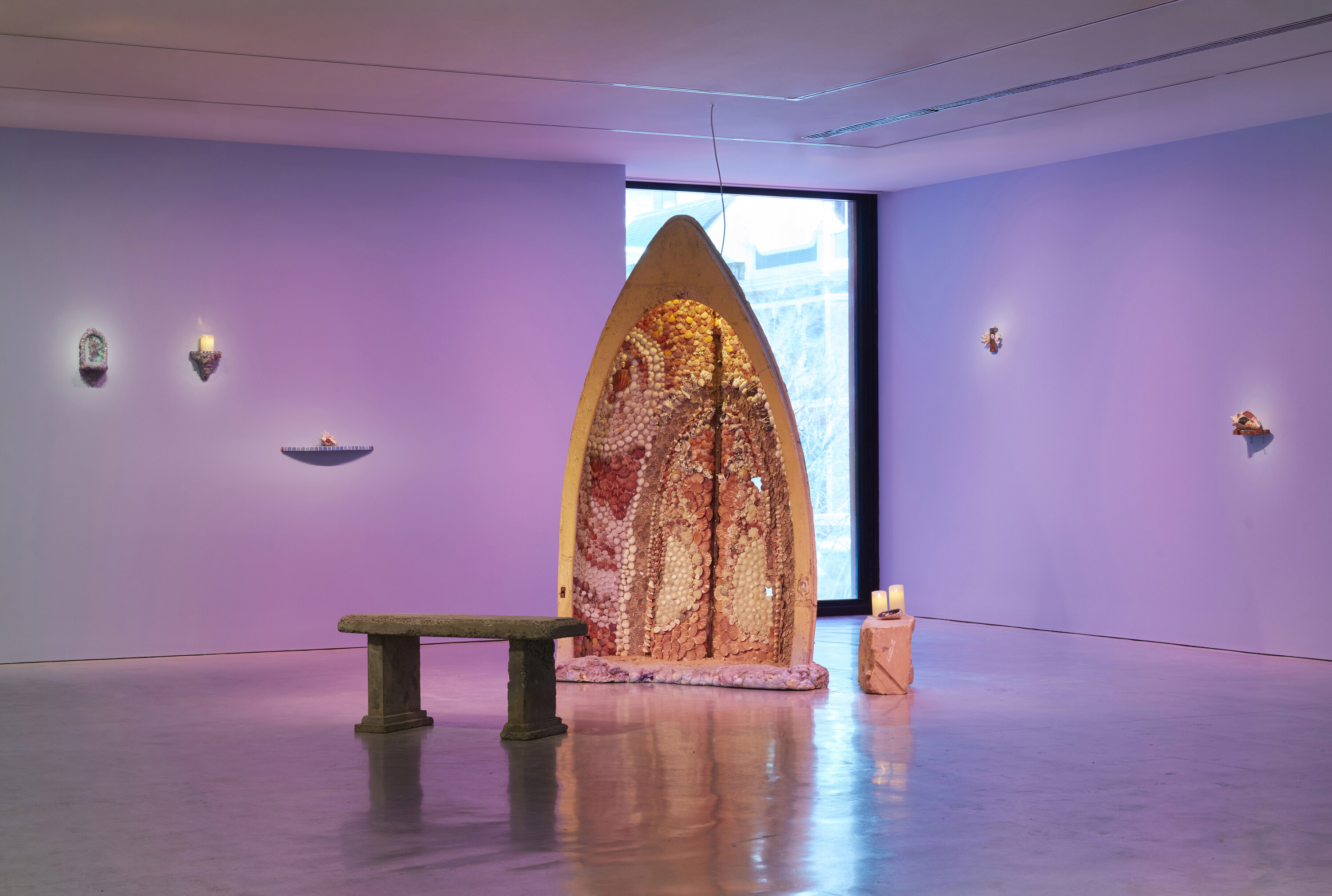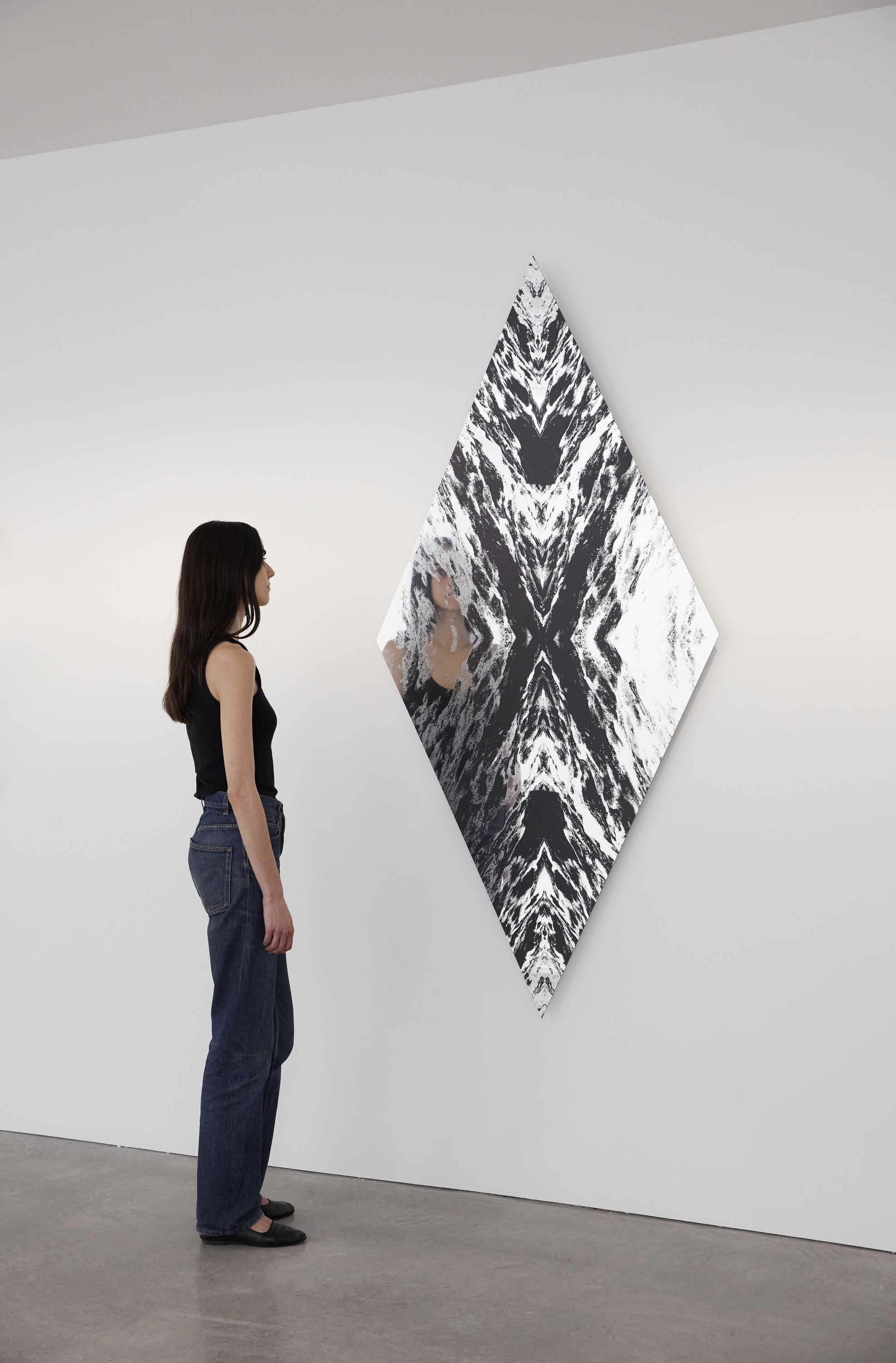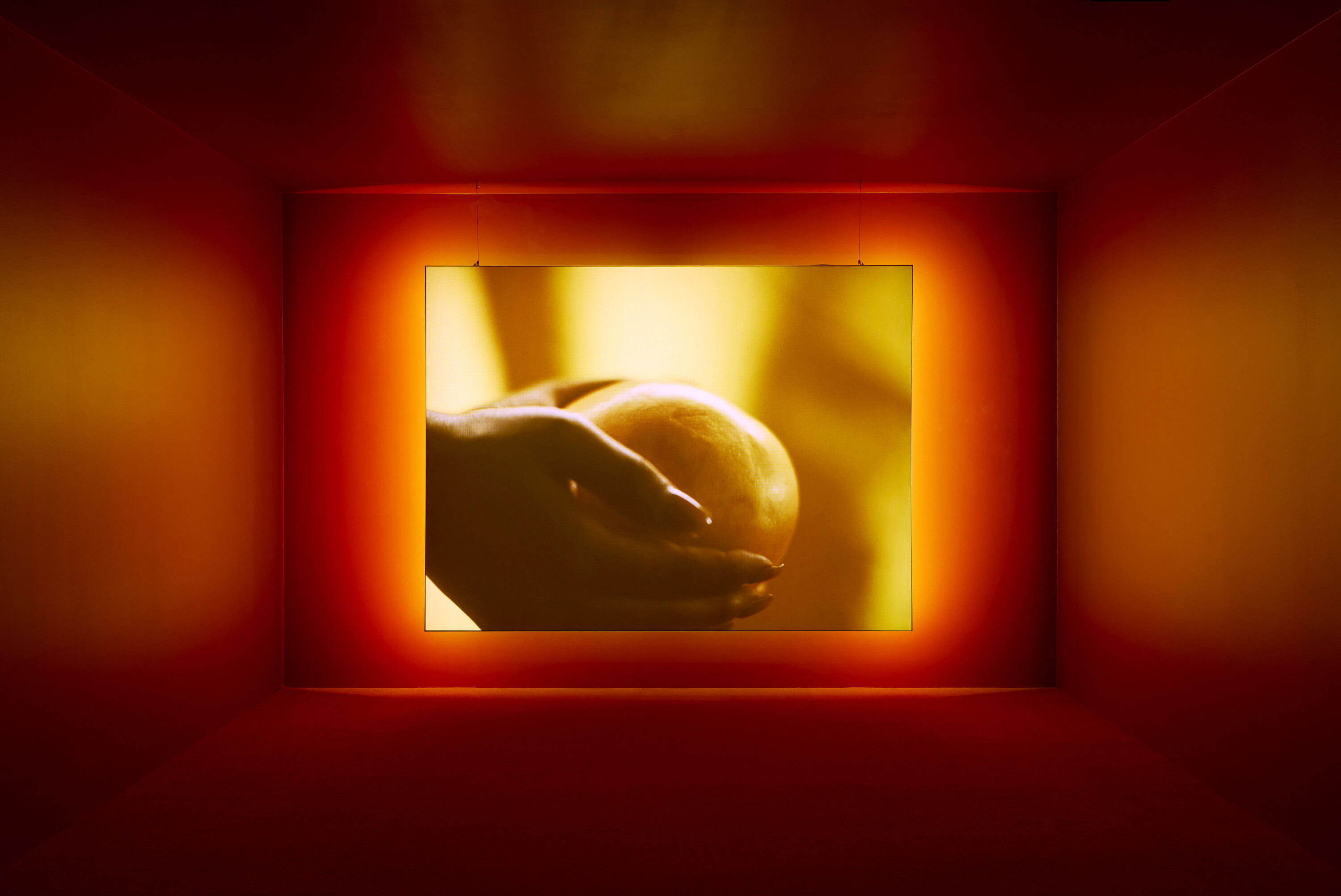Aidan Hartshorn, Yiramir Mayiny (River People), 2024, installation view, Primavera 2024: Young Australian Artists, Museum of Contemporary Art Australia, Sydney, 2024, printed vinyl on aluminium, image courtesy the artist and Museum of Contemporary Art Australia © the artist, photograph: Zan Wimberley
Primavera 2024: Young Australian Artists
Jaye Early
This year’s Primavera: Young Australian Artists at the Museum of Contemporary Art Australia is a predictable exhibition. Curated by Lucy Latella, it exhibits five emerging Australian artists exploring cultural identity, family, and technology. What might have been radical to exhibit in a museum show not long ago feels exhausted and laboured today.
Since its inception, Primavera has showcased the work of Australian artists aged 35 and under. It has played a crucial role in developing contemporary art in Australia, introducing a generation of artists early in their careers to a broader public. Over the years, the exhibition has shown a deep commitment to presenting the diversity of contemporary art practice. Disappointingly, however, it has done so in a way that has avoided any radically oppositional or interventionary gestures. In other words, despite sporadic moments of clever, inventive, and memorable curatorial maneuverers and introductions to many audacious and remarkably talented emerging artists, Primavera has maintained, overall, an allegiance to playing it safe when it comes to selecting and presenting emerging Australian artists to the public.
This sanitised approach to introducing emerging Australian artists feels dangerous when looking at our fraught early twenty-first-century landscape of needless war, unceasing global tension, fierce inequality, pending environmental collapse, an unceasing emptiness of party politics and general nihilism born out of capital’s relentless extraction. As political theorist Saul Newman recently asked: “What alternatives to our current political and economic order are being proposed? (…) Where do we look for signs of hope?”
Latella is a curator who, over the years, has shown impressive skill in presenting highly innovative artist-directed projects and exhibitions that have had critical and lasting impacts. We might think, for instance, of Latella’s work on Lucy Simpson: Holding Ground (2023), a Jackson Bella Room Commission that wonderfully evoked the freshwater rivers and lakes of her Yuwaalaraay Country in north-west NSW. Their show Julie Rrap: Past Continuous (2024), was a much-needed exhibition of one of Australia’s major art figures. Given Latella’s track record, I hoped this year would be the exception to my sustained historical disappointment with Primavera. But history almost always repeats itself.
Since the late 1990s, I have witnessed many Primavera exhibitions, leaving almost all feeling thwarted and disenchanted. They were missed opportunities: moments when contemporary Australian art and curating didn’t come into dialogue with contemporary emergencies to offer us signs of hope.
Five artists were selected for this year’s Primavera, for their ability to question how cultural identities are shaped and held and how they continue to evolve with each generation. Such artists, Latella explains, draw “on a range of media to connect with their culture, community and family, and bring to the fore that which has been concealed or overlooked.” “Their diverse works,” she continues, “highlight that culture isn’t simply inherited but formed in the present.” From this, the exhibition transpires into an, at times, appealing space where witty mixed-media installations, repurposed materials, chintzy sentimental sculptures, linguistic structures, and video work come together to transfuse participants with a subtle, layered resonance that results in a showcase of art that disappointedly contained rare moments of intrigue and interest; rare moments when the exhibition felt chancy, non-derivative, and slick.
What can be concluded from Latella’s curatorial theme is that the most pressing and relevant emerging Australian art in 2024 is art that is concerned with showcasing how cultural identity is formed, maintained, and challenged (in the past and present)—curatorial tropes that would appear to have peaked during the late 1990s. It must be said that the chosen artists succeed in addressing such issues—some more curiously and in more complex ways than others. My (somewhat unexpected) response to the exhibition is that such works, given the extent of ongoing, implicit, explicit, institutional, and everyday racism in Australia today—the type of racism that marginalises the cultural identities explored in the exhibition—should not feel so comfortable and easy to engage with.

Chun Yin Rainbow Chan (陳雋然), Long Distance Call 長途電話 (detail), 2024, installation view, Primavera 2024: Young Australian Artists, Museum of Contemporary Art Australia, Sydney, 2024, silk dye on habotai silk, wax resist, freshwater pearls, linocut print, jute twine, digital animation projection, audio track, image courtesy the artist and Museum of Contemporary Art Australia © the artist, photograph: Zan Wimberley
Exhibiting artist Chun Yin Rainbow Chan (陳雋然) has a decisively multi-disciplinary approach to artmaking, which involves immersive and cogent installations that often embrace performance, painting, weaving, and sound. Chan’s work for Primavera, Long Distance Call 長途電話 (2024) mobilises this multi-disciplinarity to give expression to her memories of phone calls that took place between her mother in Sydney and her aunt in Hong Kong after the artist’s family migrated to Australia during the mid-1990s. The work incorporates digital projection, a soundscape (a ringing telephone), and linked silk banners painted with calligraphy. The calligraphy represents the Hong Kong landscape and includes an imagined view of the artist’s late aunt’s grave, which lends the work a sorrowful tone. The installation reminds me of Chan’s The Bridal Lament, a live performance at the 2024 Liveworks Festival and OzAsia Festival in late 2023.
In the performance, Chan sang a cappella, in her ancient matrilineal mother tongue, the Cantonese dialect of Weitou (an endangered Indigenous dialect spoken by the first people of Hong Kong). Chan exquisitely evoked a porous lament by singing the bridal lament that young Weitou women sang before their weddings—a song that is full of anguish and grief. Arranged marriages between villages were once practised in the Weitou culture, and young Weitou women would learn the bridal lament before performing it as part of a pre-wedding ritual that would last days. In these performances, Weitou women would, essentially, express their grief and anguish to their families before being taken away to their new husband’s village, effectively severing all connection with their family forever. Chan’s work bravely explores the artist’s attempt to re-establish and revitalise her ancient Weitou ancestry through her mother’s family by weaving personal and historical anecdotes together to explore, essentially, love, loss, and ancestral female lineage.

Teresa Busuttil, installation view, Primavera 2024: Young Australian Artists, Museum of Contemporary Art Australia, Sydney, 2024, image courtesy the artist and Museum of Contemporary Art Australia © the artist, photograph: Zan Wimberley.
Awkwardly situated next to Chan’s work is an installation by Tandanya/Adelaide-based, Maltese-Australian artist Teresa Busuttil, entitled sinners grotto (2023). A mixed media installation that comprises a salvaged fishing boat that takes the form of a shrine or grotto encrusted with an array of seashells of varying shapes and colours that evoke not only the artist’s late father’s work as a fisherman but the sea voyage he made from Malta to Australia. Surrounding the fishing boat are various mementos and illumined candles fixed against all-encompassing, lavender-coloured walls that seem to minimise the installation, creating an ample space that doesn’t feel conducive for private reflection. Encountering the work, I felt disinclined to take up this invitation. By viewing Chan’s work beforehand, I was somewhat depleted, unable to remain captivated by Busuttil’s stories of homage and sentimentality. Both works are similar in content and intention; however, Chan’s was less prescriptive, more evocative and compelling.
Much of the focus of Walgalu and Wiradjuri artist Aidan Hartshorn’s practice is on the cultural relationships that connect his people to Country. Hartshorn’s past work has brought attention and visibility to the cultural loss and degradation that The Snowy Mountain Hydro-Electric Scheme continues to have on his ancestral homelands, Walgalu Country. Many sacred Walgalu ceremonial sites—now controlled by State Water NSW and National Parks and Wildlife Service—have become almost inaccessible since the beginning of the scheme’s construction in 1949 and the eventual occupation of Hartshorn’s ancestral homelands in the 1960s. One consequence of the scheme is a disruption of ancestral connections to Country. Hartshorn notes, “to access these spaces now, we must wait for a drought or for the water levels to drop to access the river that flows underneath, the now-still body of water.” The Yolde campground on the shore of the Blowering Reservoir is one of these now hard-to-access sites. This site traditionally would have been used as a place for gathering and preparing for ceremonies. Hartshorn’s work These Violent Delights (2024), exhibited earlier this year as part of the My Country: Country Road +NGV First Nations Commissions journey at the Ian Potter Centre: NGV Australia, addressed this history. The imposing, large-scale installation consists of sixteen suspended, low-hanging, industrial float glass shields underlit by fluorescent tubes by power produced from the Snowy Hydro System. The work symbolises the sixteen dams that make up the Snowy Hydro System that produce electricity. With these forms, Hartshorn was able to powerfully represent both the forces that had separated the Walgalu people from the Yolde campground and the cultural strength and practices that underpin the community’s resilience in the face of this separation.

Aidan Hartshorn, Yiramir Mayiny (River People) (detail), 2024, installation view, Primavera 2024: Young Australian Artists, Museum of Contemporary Art Australia, Sydney, 2024, printed vinyl on aluminium, image courtesy the artist and Museum of Contemporary Art Australia © the artist, photograph: Zan Wimberley.
Hartshorn’s Primavera work is conceptually similar to, but visually quite different from, These Violent Delights. Entitled Yiramir Mayiny (River People) (2024), the work comprises four large polished aluminium diamond shields representing the artist and his three sisters. The shields attempt to give a voice to the river water or Bila, a Walgalu ancestor that shapes the landscape and lives of the people who belong to it, but which the Scheme is now controlling and manipulating, inhibiting access to sacred sites. Enigmatic black and white photographs of river water are printed on each shield that, as Hartshorn explains, are “visual ways of seeing trauma” in response to what has been lost to him and his people.
Eora/Sydney-based artist Monica Rani Rudhar is another emerging Australian artist navigating feelings of loss and longing stemming from the complexities of multi-racial ethnicity and cultural disconnection. The work, entitled We Were Connected in a More Complicated Way Than Either of Us Could Even Begin to Understand (2023), was originally commissioned by the Powerhouse for Holi, the ancient Hindu festival of colours, a celebration of rebirth, togetherness, and the triumph of good over evil. It is one of the stronger works in the exhibition. Narrated by the artist herself, the video explores the cycles of death and renewal, the impermanence of the body and ancestral guidance across generations. In the work, the artist tells the story of her mother’s much-loved childhood pet cow, Monica. While the artist’s mother denies naming her after the cow, Rudhar uses the shared appellation as an occasion to imagine a past where she existed as the cow, enabling her to provide comfort and support during her mother’s challenging childhood. Continuing the theme of previously discussed works, the visually striking video feels lyrically dedicated to the imagination, longing, and personal and familial narratives, as well as the presence of ancestral roots across generations.

Monica Rani Rudhar, We Were Connected in a More Complicated Way Than Either of Us Could Even Begin to Understand, 2023, installation view, Primavera 2024: Young Australian Artists, Museum of Contemporary Art Australia, Sydney, 2024, single channel video, image courtesy the artist and Museum of Contemporary Art Australia © the artist, photograph: Zan Wimberley.
As Sean Lowry and Adam Geczy argue, “the contemporary artworld is underscored by… an insatiable appetite for freshly-minted-emerging talent with requisite institutional or culturally sanctioned credentials.” In other words, our art world has “an unsustainable addiction to speculative capital.” Primavera 2024: Young Australian Artists feels overwhelmingly speculative in that it is fixated on the emerging and new—yet it is also non-speculative, unable to offer something exciting that can break us out of the stale present. .
But not everything is a bad copy or meaningless repetition. The outstanding works by Chan and Hartshorn in Primavera 2024: Young Australian Artists show a steely commitment and willingness to remain brazen, cogent, and emotionally responsive to the realities of the world around us. Although our collective faith in outright revolution has diminished, artists and curators, as political actors, can still forge creative modes of resistance, subtle and ethical insurrections that contribute to an invigorated recuperation of politics without declaring a full revolt against power. It is through this willingness, going forward, that opportunities exist for Primavera, and its exhibiting artists, to take risks to create something more remarkable than rehashing digestible identity politics, or working any theme in its most predictable forms. For now, Primavera, which could easily be described as just another annual cultural gathering “celebrating” new and supposedly “provocative” art, yet doing it with little consequence.
Jaye Early is Lecturer in Contemporary Art at UNSW Art & Design, Sydney.